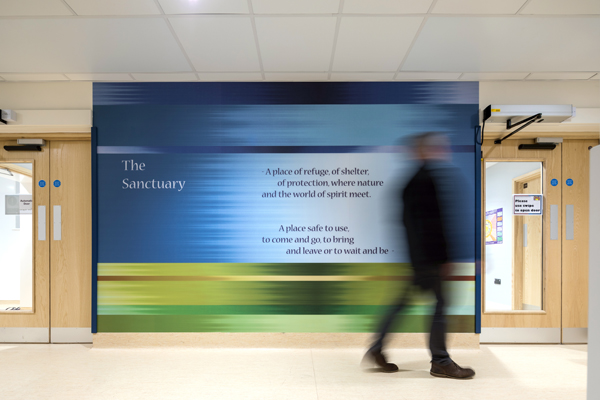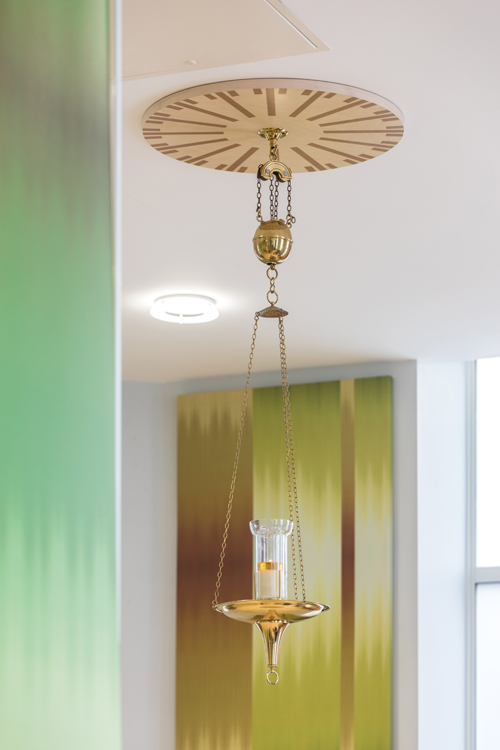‘Superstar weaver’ and colour consultant, Ptolemy Mann, has collaborated with art and health consultants, Willis Newson, to create a beautiful, innovative and transformable artwork installation for Bristol Royal Infirmary’s new Sanctuary space.
Mann creates sophisticated architectural and geometric wall hangings and prints for public and private clients using fine hand-dyed and woven fabrics.
She creates her work using Ikat, an ancient weaving technique which involves her hand dying fine cotton yarn to create delicately-gradated coloured warp threads.
This enables her to bring bold linear blocks of colour together with more-delicate areas that gently merge and blend to create her signature style.
Alongside traditional craft influences, she references modernism, abstract expressionist painting and light installation artists such as James Turrell.
She also works as an architectural colour consultant and brought her artistic skills and knowledge of colour theory to bear on the Bristol project, which presented several complex and sensitive challenges.
The Sanctuary area in a busy hospital has to be hard-working to balance the needs of different groups, communities, and faiths, as well as the diverse needs of visitors, staff, and patients.
Bronwen Gwillim of Willis Newson explains: “Mimicking the architectural norms of a chapel, mosque, or synagogue was not an option.
“A new kind of space needed to be created, one that was very contemporary in feel, spoke of quality and care, and that made everyone feel welcome.
“The space clearly needed to be one that could morph to accommodate the very-various needs of the people using it.
“For example, some faith groups require separate spaces for men and women to congregate. Alternatively, a person of no faith might be seeking a moment of privacy and refuge from the hustle and bustle of the hospital and the emotional challenges it brings.”
At the beginning of the project Willis Newson undertook creative consultation and engagement work with a range of different faith groups, the chaplaincy team, patients, and staff to inform Mann’s work for the new Sanctuary.
It was identified that the room needed to be suitable for the public and the widest-possible group of patients, visitors, and staff, to enable moments of individual privacy as well as group gatherings, to be inclusive without becoming bland, and to feel totally different to the clinical spaces in the hospital.
Mann said: “Sanctuary and faith is a complex and very personal subject for all of us – and I hope this space is able to give comfort and inspiration when needed to anyone who might pass into it.
“Colour is a powerful and healing tool and available to us all and I firmly believe we should be using more of it in our lives."
Her approach to the project included historical references to woven artworks in contemplative spaces, an appreciation of the ability of soft, acoustically-absorbent fabric installations to create the required distinctive, calm space within the busy hospital, and a desire to use a sophisticated colour palette that might evoke a connection with nature.
The colour themes of forest, sun, sky and sea are applied to the panels so they merge and change as you move around the space, with the warmer colours to the south and the cooler ones to the north.
Using a broad range of colour serves to animate the space and avoids the potential pitfall of using a colour strongly identified with one faith or a single culture.
Collaborating with Willis Newson, Mann proposed using digitally-printed lengths of robust, fire-resistant and wipeable fabric to create the artwork panels.
Mounted within Silent Gliss’s flexible Panel Glide track system in the ceiling; the panels are both static and moveable. This offered a more-elegant, practical, and easy-to-use solution to the floor-based screens as used in many hospital sanctuary spaces.
It is obvious to users of the room that the panels can be moved and patients and staff have enjoyed creating their own spaces.
The panels move independently of each other and so the viewer is invited to participate and explore options for colour and spatial combinations.

The moving panels mean that the room can be divided up to offer more-intimate spaces and complete separation of men and women as required during Muslim prayer; as well as semi-permeable screening and a completely-open space for gatherings and services.
Using the language of colour and texture of woven cloth; these screens provide a practical means of offering a place where people of all faiths, and none, can feel comfortable.
Although digitally printed; these panels were created directly from scans of hand-dyed and woven artworks; this digital translation of the hand-made enables the artist’s hand to be visible.
Two elegant circular artworks – which were painstakingly hand dyed and woven - are visible above the doorways, showing both techniques in harmony within the space.
This answered the need for both private and open spaces, a range of emotional support, and a room which has a character, ambience, and sense of quality and calm that everyone can relate to.
The end result of the project is a space which is sensitively conceived and beautifully-made, which offers a very different ambience to the busy hospital outside.





